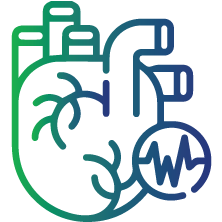
Lipoprotein (a)
Lipoprotein (a)
Lipoprotein (a) test is used to measure the level of lipoprotein(a), or Lp(a), in your blood.
Lipoproteins are made up of fat and protein. They help in carrying cholesterol throughout your blood. Lp(a) is a type of low-density lipoprotein (LDL), that is the so-called "bad" cholesterol. Plaque can build up in your blood vessels when Lp(a) levels are high. This cholesterol build-up reduces blood flow through your arteries. Elevated levels of Lp(a) is linked to high cholesterol conditions, such as coronary artery disease.
Thus, getting your Lipoprotein (a) test done is recommended to understand your risk of developing heart diseases.
What is Lipoprotein (a) levels used for?
The test is used to evaluate the presence of high lipoproteins because of:

Estrogen depletion

Hypercholesterolemia (high levels of blood cholesterol

Severe hypothyroidism (underactive thyroid gland)

Uncontrolled diabetes

Renal failure

Nephrotic syndrome (kidney disorder)
Who should get tested?
A Lipoprotein (a) test is recommended to be performed in adults who have risk factors for heart disease. Examples of risk factors include:

High cholesterol levels on a prior test

Past history of heart disease

Family history of heart disease or high cholesterol

Heart or blood vessel disease

Had multiple heart attacks or multiple operations to open heart arteries that were blocked or narrowed
Test preparation
Prior to a Lipoprotein (a) test, it is important to fast for 9 to 12 hours. Only drinking water during this time is recommended. It is advised to not drink any beverages in the morning, such as tea, coffee, or milk, until the sample collection is completed
Interpretation of the Test Results
The units of measurement for the results are mg/dL (milligrams per deciliter)
|
Parameters |
Normal reference range |
|
Lipoprotein (a) |
<30 mg/dL |
Deviation from normal levels indicate the following:
· The ideal range for Lipoprotein (a) level is below 30 mg/dL.
Having higher-than-normal levels of Lipoprotein (a) can increase your risk of cardiovascular diseases such as atherosclerosis, heart attack, and stroke.
FAQs
How is the sample collected for a Lipoprotein (a) test?
A blood sample is taken from a vein in the arm using a fine needle. This procedure typically takes no longer than five minutes
What is the turnaround time (TAT) for the results of a Lipoprotein (a) test?
What are the risks associated with a Lipoprotein (a) test?
This test involves negligible risk of infection. There might be slight bruising or tenderness around the site where the needle was inserted
Why is Lipoprotein (a) test performed?
The risk of heart disease can be elevated with high lipoprotein levels. Lipoprotein (a) test is used to check an individual’s risk of developing diseases such as atherosclerosis, stroke, and heart attack. The American Heart Association and the American College of Cardiology do not recommend this test for individuals who do not have any cardiovascular symptoms
What should you do if you have a high Lipoprotein (a) test result
In the case of an abnormal Lipoprotein (a) test result, your healthcare provider will recommend an appropriate treatment plan based on your age, family history, medical history, and current medications
If your Lipoprotein (a) levels are elevated, you should make some lifestyle changes such as making dietary adjustments, exercising regularly, and losing excess weight. You might be given a prescription for lipid lowering medications by your health care provider, if necessary

